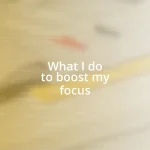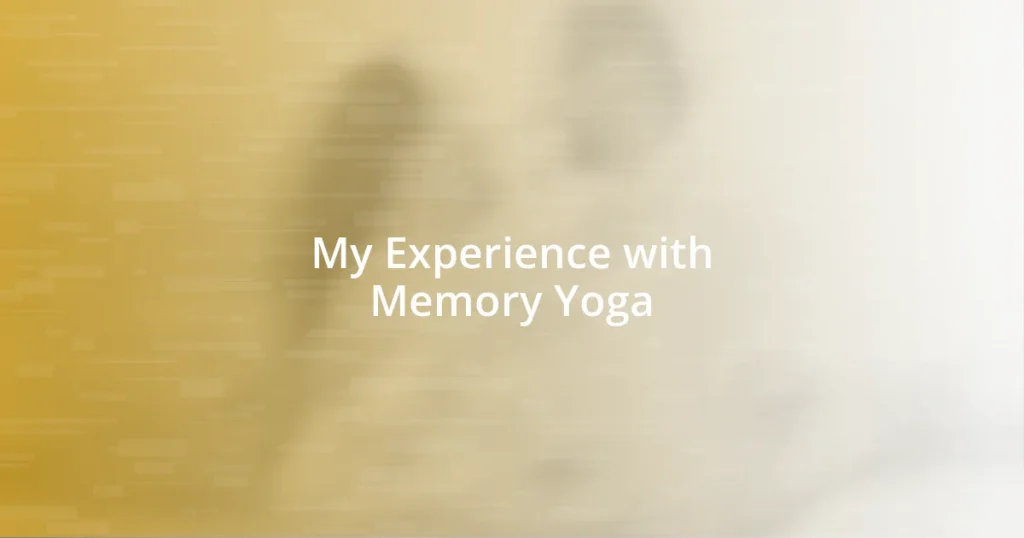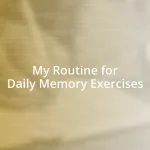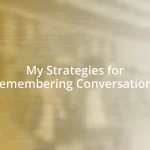Key takeaways:
- Memory Yoga combines physical yoga practices with techniques that enhance cognitive function and emotional resilience, fostering a connection between mind and body.
- Key techniques include visualization, breath coordination, mnemonic devices, and mindful movement, all of which improve memory recall and mental clarity.
- Challenges faced during practice include maintaining focus, physical strain from poses, and balancing memory techniques, highlighting the importance of patience and consistent routines for effective practice.

Introduction to Memory Yoga
Memory Yoga combines traditional yoga practices with techniques designed to enhance memory and cognitive function. I remember my first experience; I walked into a class expecting the usual stretches and found myself engaged in memory games intertwined with deep breathing and visualization exercises. It made me wonder, could something as calming as yoga actually sharpen my mental abilities?
As I delved deeper, I realized this practice isn’t just about physical postures; it’s about creating a union between the mind and body. Each pose requires focus, and I found that the more I concentrated, the more my mental clarity improved. Have you ever felt that moment when a fleeting thought suddenly crystallizes? That’s the power of Memory Yoga – it trains the mind to foster those magical moments of clarity.
The emotional connection I formed during my sessions was unexpected. I discovered that when I intertwined movement with memory techniques, I was not just learning but also nurturing my brain’s emotional resilience. What if, through something as simple as bending and breathing, we could unlock deeper layers of our memory? I believe that’s the allure of Memory Yoga; it invites us to explore not just our physical selves but also the intricate pathways of our minds.

Benefits of Memory Yoga
The benefits of Memory Yoga extend beyond the mat. During a particularly intense session, I was struck by how coordinating my breath with movement not only improved my flexibility but also boosted my concentration. It was as if each stretch aligned my mind with my body, making everything feel clearer and more cohesive. Have you ever experienced that synergy where your body feels light and your thoughts flow freely? That’s what I began to treasure about Memory Yoga — it wasn’t just physical exercise; it was a cognitive workout.
One remarkable benefit I’ve personally enjoyed is the enhancement of my memory recall. I remember struggling to remember names or details of conversations, but in just a few weeks of practicing Memory Yoga, I noticed a change. Pairing poses with mnemonic devices, I found myself effortlessly recalling names and important information. This transformation not only made social interactions more enriching but also restored a confidence I didn’t realize I had lost.
Memory Yoga also supports emotional health. There’s something inherently soothing about marrying movement with mindfulness. I often left classes feeling lighter and more at ease, and I soon realized that enhancing my cognitive function also meant nurturing my emotional well-being. It became clear to me that our mental capabilities are closely tied to our emotional states. Can you feel the positivity that arises when you’re both physically and mentally in sync? That’s the beauty of it; Memory Yoga creates this alignment effortlessly.
| Benefit | Description |
|---|---|
| Improved Concentration | Enhancing focus during practice leads to better mental clarity. |
| Better Memory Recall | Associating movements with memory techniques improves recall and retention. |
| Emotional Resilience | Combining physical movements with mindfulness nurtures emotional health. |
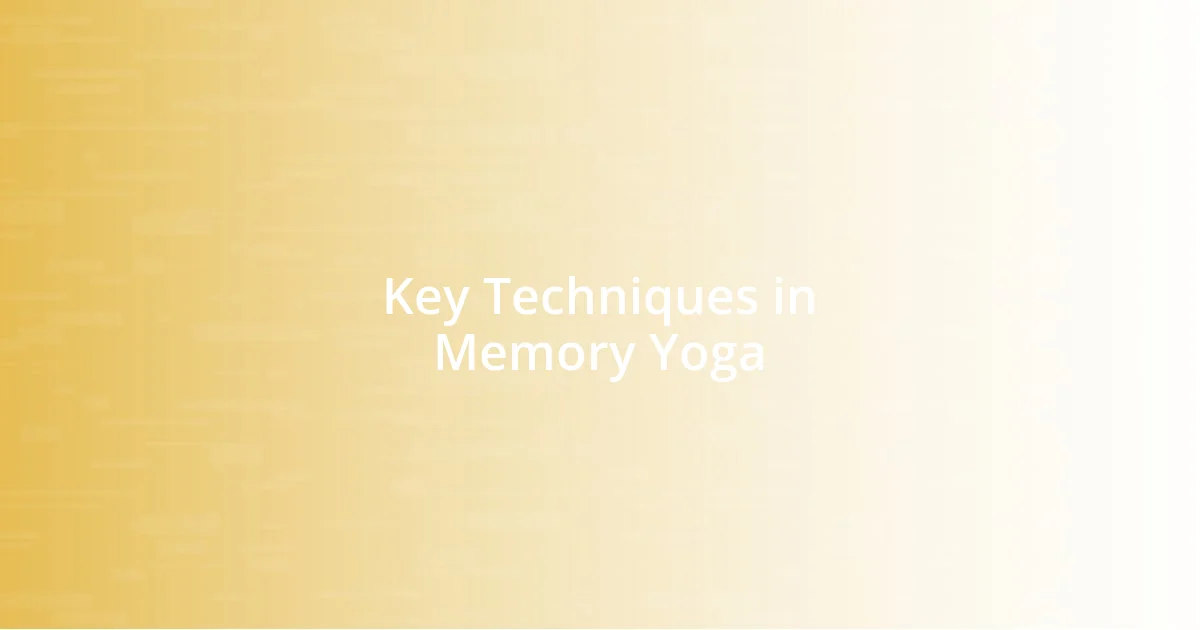
Key Techniques in Memory Yoga
Memory Yoga employs several key techniques that seamlessly blend physical movement with cognitive enhancement. One of my favorites is the integration of visualization with breathing exercises. I recall a session where we imagined ourselves in a serene garden while holding a pose. This vivid imagery not only focused my thoughts but also made the experience more memorable – a simple trick that allowed me to anchor certain memories in a tranquil setting. Additionally, we often employed mnemonic devices during poses; for example, associating specific shapes with words made retaining information feel natural and intuitive.
Here are some of the key techniques I’ve encountered in Memory Yoga:
- Visualization Practices: Imagining scenarios or images that correlate with specific memories enhances recall.
- Breath Coordination: Synchronizing breath with movements improves both mental clarity and physical execution.
- Mnemonic Devices: Associating movements with concepts or words fosters memory retention, making it easier to remember information later.
- Mindful Movement: Focusing fully on the body’s alignment and sensations during poses enhances cognitive engagement.
I remember the first time we practiced mindful movement; it felt like my body was dancing through thoughts, intertwining physical sensations with cognitive awareness. That synergy not only deepened my understanding of the poses but also expanded my mental horizons, allowing me to tap into a reservoir of memories I didn’t even know I had. Each technique unveiled new layers of my cognitive abilities and creative thinking.

Challenges Faced During Practice
Practicing Memory Yoga has certainly been a journey filled with its fair share of challenges. For instance, I often struggled with maintaining my focus during sessions. There were times when my mind would wander, drifting away from the flow of poses. Has that ever happened to you? It felt frustrating, especially when I knew how important concentration was for enhancing memory. I realized that overcoming this required patience and self-compassion as I learned to gently guide my thoughts back to the present.
Another challenge I frequently encountered was the physical strain involved in certain poses. While I enjoyed how they engaged my mind, some positions pushed my body to its limits. I remember feeling my muscles quiver, a reminder of how intertwined physical ability and mental clarity truly are. This experience taught me the importance of listening to my body, acknowledging its discomfort while pushing through that threshold. It’s a delicate balance, isn’t it? Finding that sweet spot where my body feels challenged but not overwhelmed.
Also, remembering the intricate connections between movements and mnemonic devices sometimes felt like juggling several balls at once. I’d get so caught up in trying to recall associations that I’d momentarily lose the rhythm of my breath. There were times I felt like I was multi-tasking too much, which was counterproductive. However, I learned that taking a step back and breathing through the poses allowed me to internalize the connections more naturally. It’s fascinating how, in slowing down, I found greater clarity — a rhythm that not only benefits my memory but enhances my entire practice.
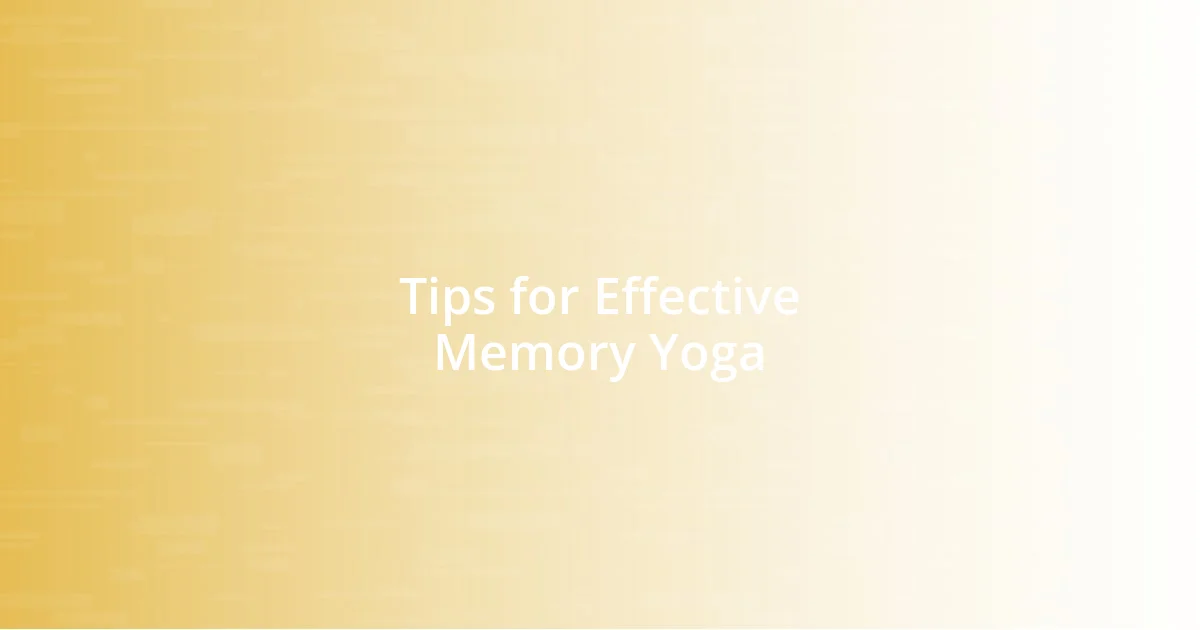
Tips for Effective Memory Yoga
To make the most of your Memory Yoga practice, I highly recommend starting with a regular routine. Consistency is key, much like training a muscle. I used to practice sporadically, but once I committed to a set time each day, I noticed a significant improvement in my focus and memory retention. Have you ever experienced a breakthrough just from maintaining a habit? It’s amazing how that daily commitment can lead to unexpected results.
Another tip that has transformed my sessions is setting clear intentions before each practice. I often take a moment to pause and think about what I want to achieve, whether it’s remembering a specific piece of information or simply enhancing my overall awareness. This practice not only helps me focus but also creates a mental anchor. I remember one day where I set the intention of deeply connecting with my breath. The subsequent poses flowed seamlessly, and my mind felt incredibly sharp. Isn’t it powerful how distraction fades away when we know precisely where to direct our energy?
Also, incorporating journal reflection after each session can be quite profound. I’ve found that jotting down thoughts about my experiences — the poses that resonated with me or the memories I felt highlighted — enriches my cognitive connections. It’s akin to reinforcing what I’ve learned in practice. During one reflective session, I came across a memory tied to a particular pose that I hadn’t thought about in years; it was like finding a hidden treasure. Have you ever stumbled upon a memory that illuminated your day? Writing it down helps solidify those discoveries and makes the practice even more rewarding.




